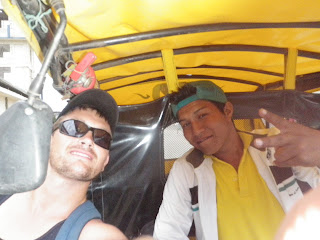A few months ago, friend and fellow intrepid traveller Zak (his amazing website is at
Sparkpunk.com) nudged me to share some favorite photos given a few prompts. Or he "tagged" me, I should say, the modern version of chain-mail. What he really did was get me to start organizing the thousands of photos I'd dumped off my cameras over the years. So, thanks for the peer-pressure Zak, and for making me see that good photography is just as much about organization as it is art...
Choosing seven photos was like trying to appeal to seven very picky little dwarves, each eager to snicker at your poor taste. But here they are (the
prompts I was given are in
bold):
A Photo That Takes My Breath Away:
 |
| Camino Choquequirao, Peru |
She passed us like we weren't even moving.
A Photo that Makes Me Smile:
 |
| Finn with Rainbow, Anchorage, Alaska |
Knowing that I have an audience who appreciates my balloon art makes me smile.
A Photo That Makes Me Dream
 |
| Cotton Grass, Umnak Island, Alaska |
In my world, plants can be clouds and clouds can be plants.
A Photo That Makes Me Think
 |
| Basement in City Lights Books, San Francisco, California |
There's been some seriously hip dudes and heavy thinkers come through this door, man. City Lights Books was stomping grounds for many writers of the Beat movement.
A Photo That Makes My My Mouth Water
 |
| Backyard Apples, Wasilla, Alaska |
You're pretty much a big deal if you can grow domesticated fruit in Alaska, it's not the easiest task. Each fall my neighbors have an apple-pressing party, where apples are squeezed in to the freshest and tastiest juice anywhere.
A Photo That Tells A Story:
 |
| Wildfire, Deering, Alaska |
Every time we heard the buzz of the engine, we cleared the line to make way for a water dump. A moment of rest just long enough for a photo.
The Photo That I'm Most Proud Of:
 |
| Paragliding, Crucita, Ecuador |
"Isn't that like talking on a cell phone while driving?" remarked one friend about mid-air photography. This is the classic, cliché paraglider's photo. I've taken many photos from this perspective, but for some reason this one really seems to resonate with people and inspire excitement (or fear) about flying in far away lands.
Since being prodded, I've started putting together a portfolio of my favorite shots which you can find
here. In the spirit of the game I shall choose a few other photographers and adventurers whose Seven Super Shots I would love to see. So, "tag, you're it!"- my picks for the
7SS Challenge are Shawn Biessel, Will Elliott, Ben Berger, Adam MacMahan, Boris Tyzsko, Rick Battle, and cuz Brian Pomeroy.
Choose your favorite seven photos to the seven prompts, and then pass the challenge on to someone new. If you're not in to the idea of using a blog, a (free) Picasa or Flickr account is worth considering, or perhaps a Facebook album. The point is, You're It! I'd love to see your shots, and I know you have other friends whose work who is simmering on a dark hard drive somewhere.
Photos are only worth their pixels when shared. After this exercise I realized that the answer to the following question is "no": "If a photo is stored on a computer and nobody sees it, was it ever really shot?"
























